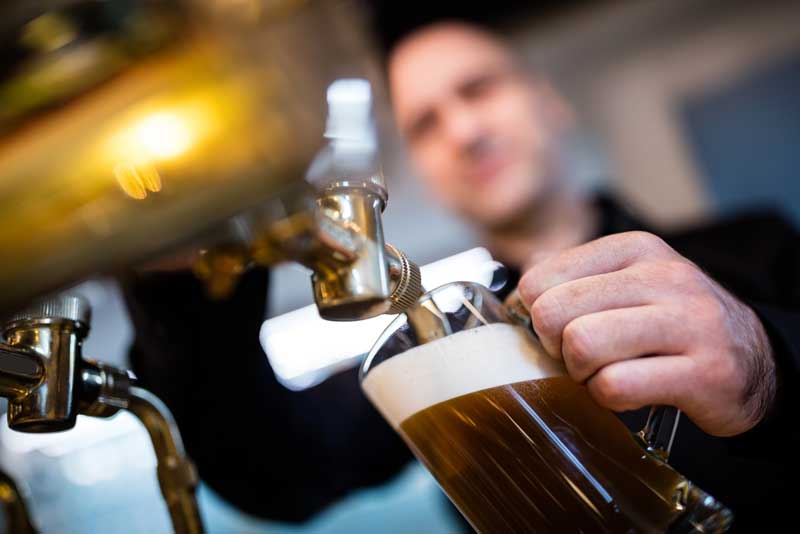When you walk into a bar or brewery, the drink menu can feel like a puzzle. Beer, ale, lager, stout, IPA, porter—the choices seem endless. But at the very heart of all these names are two terms that often confuse people: beer and ale. Are they the same thing, or are they completely different? Let’s break it down and uncover what truly sets them apart.

Beer as the Big Umbrella
Beer is the overarching family name. Every drink you know—ale, lager, stout, porter, IPA, pilsner—falls under this category. Think of beer as the root of the tree, and every other style as its branches. One of the oldest and most important branches is ale.
When you order an ale, you are technically ordering a beer. But when you simply ask for a beer, it could be many things: an ale, a lager, or one of their sub-styles. The crucial divide in the beer world lies between ale and lager.
The Key Difference Yeast
Beer is divided into two main categories: ale and lager. What sets them apart isn’t the ingredients or brewing vessels—it’s the yeast. Yeast determines fermentation speed, temperature, flavor, and even shelf life.
Ales use a yeast strain called Saccharomyces cerevisiae, also known as a top-fermenting yeast.
- Works best in warm temperatures between 60–75°F.
- Rises to the surface during fermentation.
- Ferments quickly, often in a week or less.
Lagers use Saccharomyces pastorianus, a bottom-fermenting yeast.
- Prefers cooler temperatures around 45–55°F.
- Settles at the bottom of the vessel.
- Ferments slowly over several weeks or months.
This fundamental yeast difference creates two very distinct brewing traditions and drinking experiences.
Flavor Profiles Ale vs Lager
Taste is where beer drinkers truly notice the differences:
Ales are bold, fruity, and complex.
- Warm fermentation produces esters, compounds that bring flavors like apple, pear, banana, or clove.
- More robust, layered, and expressive on the palate.
- Often fuller in body, creamier, and slightly higher in alcohol content.
Lagers are clean, crisp, and smooth.
- Cold fermentation suppresses fruity esters, highlighting malt and hops instead.
- Lighter in body with lower alcohol by volume, though there are exceptions.
- Highly refreshing, especially popular in classic pilsners.
In simple terms: ales are warm, fast, and expressive, while lagers are cool, slow, and clean.
A Matter of Alcohol and Body
Because yeast ferments more vigorously at higher temperatures, ales often end up with a stronger alcohol by volume (ABV) and provide a richer mouthfeel. Lagers, however, tend to be lighter, easier to drink, and perfect when you just want smooth refreshment.
That doesn’t mean all ales are heavy or all lagers are light—brewing traditions are filled with exceptions. Strong lagers like Doppelbocks show how powerful lagers can be, while session ales keep things light and easy without compromising flavor.
The History Behind Ale and Lager
Ale is one of the oldest beer styles in human history, while lager is a more recent innovation. Lagers originated in Central Europe, particularly in Bavaria during the 15th and 16th centuries. Brewers discovered that storing beer in cool caves created a smoother flavor and allowed it to last longer. This “lagering” process, derived from the German word lagern meaning “to store,” revolutionized brewing.
By the 19th century, with refrigeration and yeast understanding on the rise, lagers quickly spread across the globe. Today, best-selling beers like Budweiser, Heineken, and Corona are all lagers.
The Craft Beer Comeback of Ales
Despite lager’s global dominance, ales remain at the heart of the craft beer scene. Small-scale brewers love the fast fermentation and expressive flavors ales provide. This flexibility created an explosion of IPAs, Belgian-style ales, wheat beers, and quirky seasonal brews.
Craft brewing has helped revive ale’s reputation as the style for experimentation and flavor exploration. While lagers may dominate the mass market, ales win the hearts of enthusiasts seeking bold, character-driven profiles.
Common Misconceptions Cleared
A major source of confusion is how people use the word “beer.” Many drinkers casually say “beer” when they actually mean “lager.” But remember—ale is just as much beer as lager is.
Another myth is that ales are always heavy while lagers are always weak. In reality, the brewing world blurs these lines constantly with stronger lagers and lighter ales.
Choosing Between Beer vs Ale
So, how should you decide what to drink? It all comes down to mood:
- If you want something expressive, bold, fruity, and layered, choose an ale.
- If you’re looking for something crisp, clean, refreshing, and simple, reach for a lager.
Neither is better than the other—it’s simply about what you’re in the mood for.
Conclusion
At the end of the day, beer is the family, and ale and lager are its two most important branches. Ales showcase warmth, speed, and flavor complexity, while lagers deliver cool, slow, and refreshing balance. Both carry centuries of tradition and continue to evolve with brewers around the world.
Next time someone asks about the difference between beer and ale, you’ll be ready with the full story: one is expressive and bold, the other is crisp and clean, and both proudly belong to the same family.
